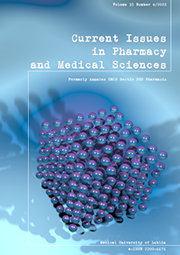Features of the ultrastructure of the skin of white rats 30 days after modeling of portal hypertension
DOI:
https://doi.org/10.2478/cipms-2022-0029Keywords:
portal hypertension, ultrastructure of the skin, electron microscopyAbstract
The problem of skin repair under the conditions of systemic increased pressure in microvessels has a great importance. This is due to the fact that each year the incidence of this pathology has seen an increase during different operations, including plastic surgery. As the compensatory and reparative mechanisms occurring in the skin affected by vascular hyperbaria are still unidentified, the aim of the study was to investigate the features of the ultrastructure of the skin of white rats 30 days after modeling of portal hypertension. Objects of the study were anterior abdominal wall biopsies for electron microscopy research.
Our work demonstrated that the skin in intact animals (control group) was of typical structure before the beginning of the experiment and 30 days after a sham operation. Following 30 days modeling of portal hypertension, the ultrastructure of the epidermis was found to be intact, only slight thickening of the horny layer was revealed. However, in the basal epidermocytes, signs of crypts formation by cytolemma were revealed. Moreover, in the epidermocytes of the spinous and granular layers, the mitochondria, endoplasmic reticulum channels and ribosomes were almost non-evident. In addition, in the cytoplasm of the fibroblasts, a moderate amount of freely located ribosomes and a moderate number of polymorphic mitochondria were detected, while the lumens of the capillaries of the papillary layer of the dermis were narrowed. We also saw that the swelling of the cytoplasm in endothelial cells resulted in the narrowing of the microvessels lumen. What is more, the subendothelial zone was expanded – which is indicative of endothelial desquamation. Beyond the aforementioned, the nuclei of the endothelial cells were well contoured and had signs of chromatin condensation. Endothelial cells with signs of apoptosis were detected as well.
References
1. Maricevich MA, Adair MJ, Maricevich RL, Kashyap R, Jacobson SR. Facelift complications related to median and peak blood pressure evaluation. Aesthetic Plast Surg. 2014;38(4):641-7. Review match
2. Park DM. Total facelift: Forehead lift, midface lift, and neck lift. Arch Plast Surg. 2015;42(2):111-25. Review match
3. Cason RW, Avashia YJ, Shammas RL, Savetsky IL, Rohrich RJ. Perioperative approach to reducing hematoma during rhytidectomy: What does the evidence show? Plast Reconstr Surg. 2021;147(6):1297-309. Review match
4. Swanson E. Evaluation of face lift skin perfusion and epinephtine effect using laser fluorescence imaging. Plast Reconstr Surg Glob Open. 2015;3(8):e484. Review match
5. Baker DC, Stefani WA, Chiu ES. Reducing the incidence of hematoma requiring surgical evacuation following male rhytidectomy: A 30-year review of 985 cases. Plast Reconstr Surg. 2005;116(7):1973-85. Review match
6. Swanson E. Prospective study of Doppler ultrasound surveillance for deep venous thromboses in 1000 plastic surgery outpatients. Plast Reconstr Surg. 2020;145:85-96. Review match
7. Varon J, Marik PE. Perioperative hypertension management. Vasc Health Risk Manag. 2008;4(3):615-27.
8. Chung KH, Cho MS, Jin H. Perioperative hypertension management during facelift under local anesthesia with intravenous hypnotics. Arch Plast Surg. 2017;44(4):276-82. Review match
9. Trussler AP, Hatef DA, Rohrich RJ. Management of hypertension in the facelift patient: results of a national consensus survey. Aesthet Surg J. 2011;31:493-500. Review match
10. Conn HO. Portal hypertension, varices and transjugular intra-hepatic portosystemic shunts. Clin Liver Dis. 2000;4(1):133-50. Review match
11. Gunarathne LS, Rajapaksha H., Shackel N, Angus PW, Herath CB. Cirrhotic portal hypertension: from pathophysiology to novel therapeutics. World J Gastroenterol. 2020;26(40):6111-40. Review match
12. Königshofer P, Brusilovskaya K, Schwabl P, Reiberger T. Animal models of portal hypertension. Biochim Biophys Acta Mol Basis Dis. 2019;1865(5):1019-30. Review match
13. Abraldes JG, Pasarin M, Garcia-Pagan JC. Animal model of portal hypertension. World J Gastroenterol. 2006;12(41):6577-84.
14. Sikuler E, Kravetz D, Groszmann RJ. Evolution of portal hypertension and mechanisms involved in its maintenance in a rat model. Am J Physiol. 1985;248:G618-G25. Review match
15. Zhu W, Song H. A rare case of recurrent lower extremity ulcer. Int J Low Extrem Wounds. 2019;18(4):389-92.
16. Van Buuren HR, Fick TE, Schalm SW. Recurrent bleeding from cutaneous venous collaterals in portal hypertension. Gut. 1988;29(9):1279-81. Review match
17. Godara SK, Thappa DM, Pottakkatt B, Hamide A, Barath J, Munisamy M, et al. Cutaneous manifestations in disorders of hepatobiliary system. Indian Dermatol J Online. 2017;8(1):9-15. Review match
18. Sato I. Cutaneous manifestations of liver cirrhosis. Nihon Rinsho. 1994;52(1):170-3.
19. Hrytsevych NR, Vereschaka VV. Features of the ultrastructure of the skin of white rats 60 and 90 days after modeling of portal hypertension. Wiad Lek. 2021;74(9 part 1):2197-201. Review match
Downloads
Published
Issue
Section
License
Copyright (c) 2023 Authors

This work is licensed under a Creative Commons Attribution-NonCommercial-NoDerivatives 3.0 Unported License.


